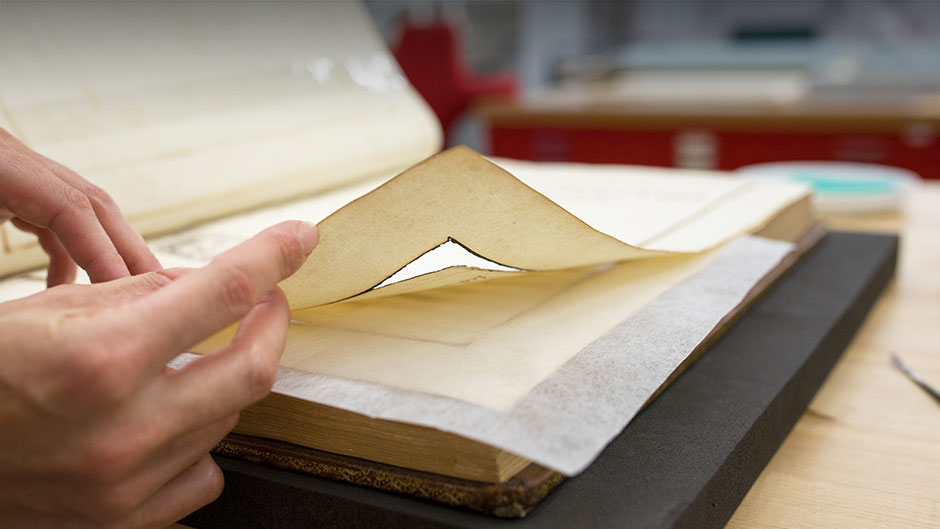What’s old is new again: Reviving history at the U
Amanda Perez, 08-31-2018

Deep inside the new Kislak Center at the University of Miami’s Otto G. Richter Library, a team of conservators is hard at work preserving documents, some that date back hundreds of years.
Martha Horan, head of preservation strategies, notes that the lab “is a state-of-the-art facility, and the only paper and book lab in South Florida. Having a lab like this requires a specific skill set and specialized equipment that not all universities have.”
On a recent visit, Laura Fedynyszyn, an Andrew W. Mellon Conservation Fellow, and conservator Duvy Argandona, sift through extraordinary compositions that come their way on a daily basis. One book, currently in the conservation process, dates back to 1718. Fedynyszyn, who’s performing the conservation treatment, reveals the book is a copy of the Maronis Opera, written by the famous Roman poet Publius Vergilius Maro. The copy is originally thought to have been owned by French Lieutenant-General Francoise Grouvel.
“It was written in calligraphy with iron gall ink by Giocobbe Mansoni. The problem with the ink is that over time it tends to corrode and eat through the paper. Now I’m going page by page repairing all of the borders. This has been one of my projects the last three weeks,” said Fedynyszyn.
The Conservation Lab opened its doors in 2010 inside the Richter Library, immediately adjacent to the recently opened Kislak Center, which was established with a landmark gift in 2017 from the Jay I. Kislak Foundation and now houses UM Libraries departments of Special Collections and University Archives. The constant growth at the library has helped the University get ranked among the top 50 research libraries in North America.
Charles Eckman, dean of UM Libraries, believes the Conservation Lab is critical to the way in which the Libraries grow distinctive collections. “It ensures that we’re able to preserve the content we get as part of those programs,” he said. “It’s a unique trait of our library and one of a kind in South Florida. We only have two conservation labs in Florida. One at the University of Florida, and the other here in Miami.”
Argandona is a conservator who has been with the lab since its opening. “Every day you see something different. It’s sometimes challenging, but it makes your job exciting and unique.”
Part of Argandona’s job is to safeguard documents that at times bring a feeling of nostalgia into the room. Her latest task is to use a machine called an ultrasonic welder to encapsulate a Miami tourist pamphlet dating back to the 1920s. The process of encapsulation seals the document on all four sides, keeping it protected for years to come. Gazing at the pamphlet gives a person an inside look at an earlier landscape of Miami, once advertised as the “Land of Palms and Sunshine” and “The Wonder City of America.”
Moving across the room, the lab’s newest treasure by female Cuban artist Digdora Alonso is on full display. The eye-catching piece of manuscript titled Cuento para un hombre que lloró tapándose el rostro, is one of several pieces that will soon be displayed inside the Cuban Heritage Collection’s newest art exhibit, slated to open later this fall. The future exhibit centers around handmade artist books created in Matanzas, Cuba, beginning in the 1980s under the publishing house called Ediciones Vigía. It will all be part of the larger collection at Richter that has grown to become the most important and expansive body of materials on Cuba outside the island.
Fedynyszyn, who is assisting in the project to help restore the pieces, thinks her work inside the lab is making an impact not only to the UM community, but to South Florida as a whole. “I know the Cuban Heritage Collection is very important to a lot of people in the community. It’s accessed by a lot of Cubans living here in Miami, a lot of people come to research it. We make sure those materials are kept safe for generations to come,” she said.
Eckman also agrees the library is a great resource to the community. “The lab is ensuring the content we’re providing in the library is used not only for our faculty, but also members of the international community. People come from all over the world to use the unique holdings of Special Collections, University Archives and the Cuban Heritage Collection. I think the beneficiaries include anyone interested in history and creative use of books, manuscripts, photography and other unique objects on paper,” he said.
Looking into the future, the Conservation Lab has no plans to slow down. Eckman is ready to see the lab flourish even more in the years to come.
“I think we see the role of the lab growing both internally and externally. We would like to see the lab expand its treatment options. We’re also trying to find a way to develop a model to promote preservation services beyond the University of Miami. We want to make it a regional resource,” he said.
Horan is also in tune with the common goal, and is ready to take the next steps toward even more success.
“We want to keep on maintaining equipment and keep on developing and learning new techniques to continue our research and share what we do,” Horan said.